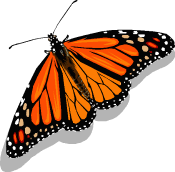Get butterflies to flutter by in your garden

by Lydia Alexander, Master Gardener Volunteer
Florida is home to about 160 resident butterfly species, including the Zebra longwing, the state butterfly. The university of Florida's Maguire Center for Lepidoptera research is set to open in 2004. The proposed 40,000-square-foot center will be devoted principally to housing one of the world's largest Lepidoptera collections and research facilities. It will also contain a live butterfly exhibit.
· In the scientific world butterflies are considered to be an indicator of environmental health, because of their sensitivity to pesticides.
· Today, butterflies are enjoying renewed popularity and now is a good time to plan your summer garden to attract certain types of butterflies.
· Start with research and find which butterflies are native to our area, and the types of plants those butterflies are attracted to. Visit the University of Florida IFAS Extension Web site at: http://edis.ifas.ufl.edu/. Enter: WEC-22 in the "Publication number " ( Butterfly Gardening in Florida) .Choose your area of Florida. You will find a list of butterflies found in our area and their preferred food sources.
· The requirements for a butterfly garden are quite simple and are virtually no different from those for any other wildlife species.
· First, find a sunny protected location, where you can observe the butterflies from inside your home as well as outside.
· Butterflies get thirsty too. Provide a puddle area, wet sand, earth, mud make the best watering holes, fill a pan with beach sand add a rock for sunning and resting and .keep it moist if there is no rain .
· Select nectar-producing flowers to ensure a progression of bloom from spring thru autumn. A mix of colorful annuals, perennials trees and shrubs: asters, coreopsis, zinnias, tithonia (Mexican sunflower), lantana, Buddleia, and pentas, coneflowers.
· Include larval food plants on which the female butterflies can lay their eggs. Some caterpillars feed on just one type of plant. Some larval food plants are: dill, parsley fennel for Black swallowtail, milkweeds for Monarch and Queen, Passion Vine for Gulf frittilary, Citrus and Rue for giant Swallowtail. Willows and Popular trees for Tiger swallowtails. These plants will encourage butterflies to stay and provide a chance to observe the incredible transformation of caterpillars to butterflies .
· The United States Geological Survey has a Children's Butterfly site at: http://www.fort.usgs.gov/resources/education/butterfly/bfly_intro.asp
· National Garden Bureau has a web site at: www.ngb.org
· For more information on gardening in our area, visit the University of Florida IFAS Extension Web site for Jackson County At: http://jackson.ifas.ufl.edu/
Page created and maintained by West Florida Electric Cooperative, Inc. © 2001.
designed by embryo design